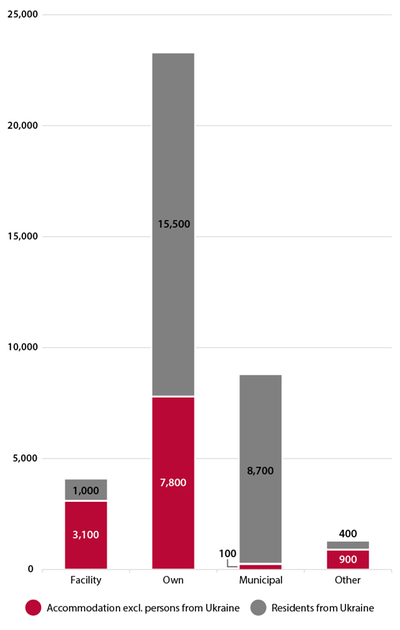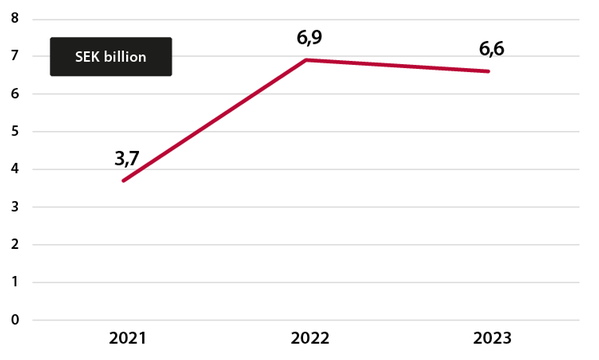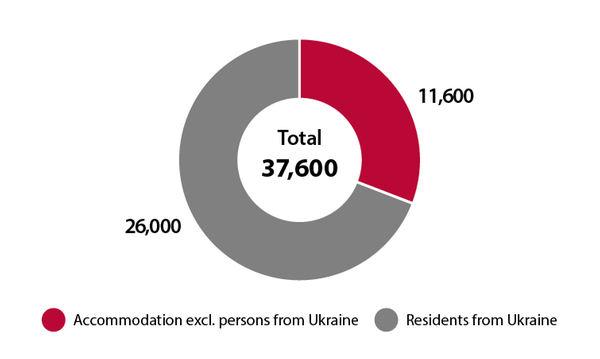The Swedish Migration Agency answers: The reception and housing of asylum seekers – how does it work?
Changes are being made to the system for housing asylum seekers. In this article, we will answer some of the questions about how asylum seekers are housed today and how the system will operate in future.
How are asylum seekers housed today?
People who apply for asylum in Sweden are entitled to accommodation and financial support while they await a decision. Since the 1990s, this has meant asylum seekers choosing whether they wish to live in one of the Swedish Migration Agency's accommodation centres or arrange their own accommodation. In either case it has been possible to receive financial support.
Swedish Migration Agency accommodation centres
The temporary accommodation offered by the Swedish Migration Agency is located in various centres around the country. You are not entitled to choose where you live. You may also be required to move to other accommodation while you are awaiting a decision. Accommodation is often in a flat that is shared with others. Single people must share a room with others of the same sex. Families are always given a room of their own.
 Zoom image
Zoom imageThe diagramme shows the number of applicants in the system in each type of accommodation. The total number of persons in the system amounts to around 37 000.
Arranging your own accommodation
Asylum seekers applying for a Swedish residence permit may choose to arrange their own accommodation. Some residential areas of Sweden are classed as socioeconomically vulnerable and, in order to reduce the risk of overcrowding and social exclusion, a few years ago restrictions were imposed on asylum seekers choosing to arrange their own accommodation in these areas. If you do choose to arrange your own accommodation in an area designated as vulnerable, you will therefore lose your entitlement to financial support.
The Government recently referred a proposal to the Council on Legislation for consideration that, among other things, will further limit the right of asylum seekers to arrange their own accommodation. The Government proposes that, as a general rule, only asylum seekers living in the accommodation centre to which they are assigned by the Swedish Migration Agency will be entitled to financial support.
A new arrangement for asylum seekers' accommodation External link, opens in new window. (in Swedish)
External link, opens in new window. (in Swedish)
Learn about vulnerable areas on the page Your own accommodation
Unaccompanied refugee minors are referred to the municipality
There is a separate form of reception for children who arrive in Sweden seeking asylum without a parent or legal guardian, who are referred directly to the municipality. The municipality will arrange for a court-appointed guardian, accommodation, school, etc.
Refugees from Ukraine
Some 50,000 Ukrainians arrived in Sweden under the Temporary Protection Directive immediately after Russia’s invasion of Ukraine. To deal with this influx of displaced persons seeking protection, legislation was passed to the effect that all Ukrainians granted a residence permit under the Directive were to be immediately referred to a municipality. The majority of those registered in the Swedish Migration Agency’s reception system are therefore people from Ukraine who have either arranged their own accommodation or who live in municipal housing. Those who have been in Sweden for a specified period of time can now register in the Swedish Population Register.
 Zoom image
Zoom imageThe diagramme shows the annual cost of the system for housing and financial support in 2021-2023 (in billions).
A brief history: Many commissions of inquiry
Since 2015, the terms of reference of a number of commissions of inquiry have been formulated to fundamentally change how Sweden receives asylum seekers.
The previous government appointed two commissions of inquiry, one of which proposed that municipalities should take over the main responsibility, while another recommended the creation of state-run reception centres for asylum seekers.
An orderly reception: Joint responsibility for swift establishment or return External link, opens in new window. (in Swedish)
External link, opens in new window. (in Swedish)
An orderly initial reception of asylum seekers (Dir. 2021:71) External link, opens in new window. (in Swedish)
External link, opens in new window. (in Swedish)
The present government has supplemented the terms of reference for the inquiry into an orderly initial reception of asylum seekers.
In summary, it is fair to say that inquiries into how the reception system should be reformed have been ongoing for some time now, and it is against this background that the Commission of Inquiry presented its report on 15 October 2024 External link, opens in new window. (in Swedish).
External link, opens in new window. (in Swedish).
The future reception system
The Government is keen for asylum seekers to live in reception or return centres, with the aim of improving the efficiency of both the asylum process and the return process. The Commission of Inquiry into an orderly initial reception of asylum seekers presented its final report in October 2024, effectively redrawing the entire reception system.
The commission proposes a completely new law on the orderly reception and effective return of asylum seekers. Here, we present some of the proposals presented in the commission’s interim report (SOU 2022:64) External link, opens in new window. (in Swedish).
External link, opens in new window. (in Swedish).
The commission's proposals
- In order to receive certain benefits, asylum seekers must accept accommodation in the Swedish Migration Agency's accommodation centres. This is intended to reduce the percentage of asylum seekers choosing to arrange their own accommodation.
- Asylum seekers shall be subject to mandatory attendance checks at accommodation centres. In certain cases, the Swedish Migration Agency may instead decide to impose a reporting obligation.
- If asylum seekers break the rules – such as failing to report to the accommodation centre as instructed – they may lose some or all of their daily allowance. Under certain conditions, an asylum application could be considered to be withdrawn and the person in question would then lose the rights that asylum seekers have.
- Persons subject to a deportation order shall be required to live in asylum-seeker accommodation, to report to the Swedish Migration Agency on three days each week and to remain within the county in which they reside. Entitlement to a daily allowance shall be conditional on actively participating in the return process, otherwise detention may be necessary.
- The daily allowance shall be calculated as a percentage of the national standard for income support.
- Asylum seekers shall be prohibited from entering the labour market until six months after their asylum application was submitted.
Assignment to prepare for the transition
The Government's assignment to the Swedish Migration Agency states that the agency shall prepare for the transition to reception centres (collective accommodation) and that the transition from living in apartments to collective accommodation is to be completed as swiftly as possible.
The assignment is to create an orderly reception that promotes more effective asylum and return processes. Offices examining asylum applications are to be located at or close to accommodation centres and it must be easy for asylum seekers and staff at the Swedish Migration Agency to reach one another
The needs and rights of, for example, children, LGBTQ+ persons, people with disabilities and those at risk of being subjected to violence must be protected by providing safe and secure accommodation. When designing accommodation centres, the agency shall also give due consideration to gender equality and the child’s right to schooling. There must also be opportunities for activities at accommodation centres.
The EU's Pact on Migration and Asylum is a factor
The EU's recently adopted Pact on Migration and Asylum will impact the design of the reception system. Over the past year, the Swedish Migration Agency has therefore studied how other Member States receive asylum seekers. This is being done in light of the changes to the reception of asylum seekers that the Pact on Migration and Asylum will involve.
